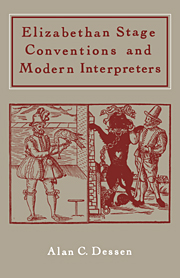Book contents
- Frontmatter
- Contents
- Preface
- Note on texts and old spelling
- 1 The arrow in Nessus: Elizabethan clues and modern detectives
- 2 Interpreting stage directions
- 3 The logic of ‘this’ on the open stage
- 4 Elizabethan darkness and modern lighting
- 5 The logic of ‘place’ and locale
- 6 The logic of stage violence
- 7 Theatrical metaphor: seeing and not-seeing
- 8 Conclusion: Elizabethan playscripts and modern interpreters
- Notes
- List of plays and editions
- Index
7 - Theatrical metaphor: seeing and not-seeing
Published online by Cambridge University Press: 22 September 2009
- Frontmatter
- Contents
- Preface
- Note on texts and old spelling
- 1 The arrow in Nessus: Elizabethan clues and modern detectives
- 2 Interpreting stage directions
- 3 The logic of ‘this’ on the open stage
- 4 Elizabethan darkness and modern lighting
- 5 The logic of ‘place’ and locale
- 6 The logic of stage violence
- 7 Theatrical metaphor: seeing and not-seeing
- 8 Conclusion: Elizabethan playscripts and modern interpreters
- Notes
- List of plays and editions
- Index
Summary
‘I now am blind.’
‘What's your conceit in this?’
(The Duchess of Malfi, i. i. 494)To consider metaphoric or symbolic stage violence is inevitably to raise large (and often unanswerable) questions about Elizabethan playscripts, particularly those of Shakespeare. As noted throughout this study, the sparseness of stage directions in the extant manuscripts and printed texts continually frustrates attempts to link staging and imagery at key moments, so that I find it impossible to establish any firm connections between the staging of the death of a Richard III (or Richard II) in the 1590s and one or another iterative pattern woven through the fabric of the play. Even when stage directions do survive, they often do not make immediate sense in imagistic terms to today's critic or director and, as a result, may be bumped out of the text into the textual notes by the editor. Thus, as noted in chapter one, the Nurse's intervention to prevent Romeo's suicide as set forth in the first or ‘bad’ quarto was rejected by the editor of the New Arden edition as ‘gratuitous and distracting’ even though the resulting stage picture fits well with the emphasis in the dialogue upon a ‘womanish’ or ‘effeminate’ Romeo.
- Type
- Chapter
- Information
- Elizabethan Stage Conventions and Modern Interpreters , pp. 130 - 155Publisher: Cambridge University PressPrint publication year: 1984



